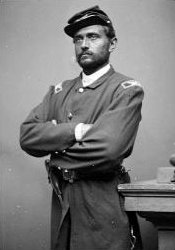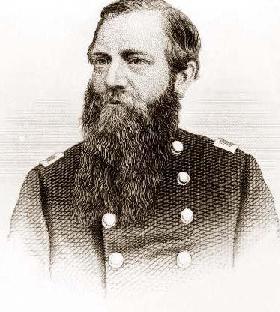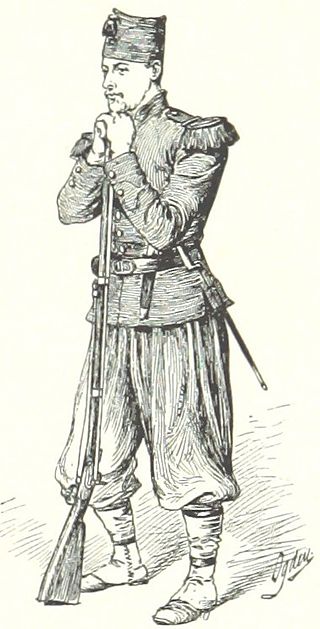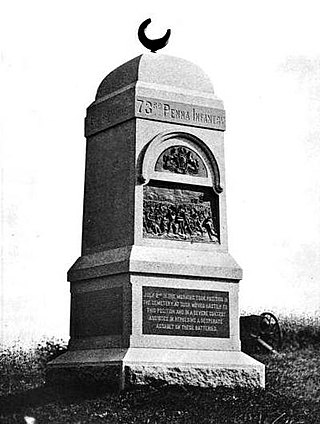
Ambrose Powell Hill Jr. was a Confederate general who was killed in the American Civil War. He is usually referred to as A. P. Hill to differentiate him from Confederate general Daniel Harvey Hill, who was unrelated.

The 11th Pennsylvania Infantry Regiment was a Union army regiment that participated in the American Civil War. It had the distinction of being the oldest unit in continuous service from Pennsylvania.

Theophilus Francis Rodenbough was born in Easton, Pennsylvania and was a Union Army officer during the American Civil War. He received America's highest military decoration the Medal of Honor for his actions at the Battle of Trevilian Station. After his retirement from the U.S. Army in 1870, he wrote several books about military history.
The 14th Indiana Infantry Regiment, called "The Gallant Fourteenth," was an infantry regiment and part of the Union Army's celebrated "Gibraltar Brigade" during the American Civil War. Mustered on June 7, 1861, it was the state's first regiment organized for three years' service. The 14th Indiana served in many major campaigns and battles mostly in the Eastern Theater. During its three years of service, the regiment had a total of 222 casualties.

John Lawrence Burns was an American soldier and constable. A veteran of the War of 1812, at age 69 he fought as a civilian combatant with the Union Army at the Battle of Gettysburg during the American Civil War. He was wounded, but survived to become a national celebrity.

Augustus van Horne Ellis was an American lawyer, sea captain, and soldier. He was a brevet brigadier general in the Union Army during the Civil War, and was killed in action at the Battle of Gettysburg.
The 74th Pennsylvania Volunteer Infantry was an infantry regiment which served in the Union Army during the American Civil War. It was one of many all-German regiments in the army, most notably in the XI Corps of the Army of the Potomac. Its combat record was marred by the perceived poor performance of the entire corps at Chancellorsville and Gettysburg, when parts of the corps routed during Confederate attacks.

Richard Coulter, Sr. was an American Civil War Colonel and brevet brigadier general of volunteers in the Union Army, a businessman, and banker. During the Civil War he was colonel of the 11th Pennsylvania Infantry, often rising to brigade command upon the wounding of superior officers. In 1866, he was nominated and confirmed as a brevet major general of volunteers to rank from April 1, 1865.
The 6th Ohio Cavalry Regiment was a cavalry regiment of the Union Army, which was raised in ten counties in northeastern and north-central Ohio for service during the American Civil War. It served primarily in the Eastern Theater in several major campaigns of the Army of the Potomac and was particularly active during the Gettysburg Campaign of 1863.

The Pennsylvania State Memorial is a monument in Gettysburg National Military Park that commemorates the 34,530 Pennsylvania soldiers who fought in the July 1 to 3, 1863 Battle of Gettysburg during the American Civil War. The memorial stands along Cemetery Ridge, the Union battle line on July 2, 1863. Completed in 1914, it is the largest of the state monuments on the Gettysburg Battlefield.

The 83rd Pennsylvania was a volunteer infantry regiment in the Union Army during the American Civil War, which participated in almost every major battle in the East, including Seven Days Battles, Antietam, Fredericksburg, Gettysburg, Petersburg and Appomattox Court House.

The 1st Maryland Cavalry Regiment was a cavalry regiment of the Union Army during the American Civil War.
The 75th Regiment Pennsylvania Volunteer Infantry was a unit of the Union Army during the American Civil War. It was composed almost entirely of German-speaking residents of Philadelphia and newly arrived German immigrants. Total enrollment, over the course of the war, was 1,293 officers and men. The 75th Pennsylvania participated in several major battles including Second Bull Run, Chancellorsville, and Gettysburg. The regiment was transferred to the Western Theater in September, 1863. There, it participated in operations in Tennessee, before it was mustered out of service on September 1, 1865, following the close of the war.
The 88th Regiment, Pennsylvania Volunteer Infantry was an infantry regiment that served in the Union Army during the American Civil War.

The 56th Pennsylvania Volunteer Infantry was an infantry regiment that served in the Union Army during the American Civil War. The unit has the distinction of being the first Union Army infantry regiment to open fire at the Battle of Gettysburg.
The 11th Pennsylvania Reserve Regiment also known as the 40th Pennsylvania Volunteer Infantry was an infantry regiment that served in the Pennsylvania Reserves infantry division of the Union Army during the American Civil War.

The 73rd Pennsylvania Volunteer Infantry was an infantry regiment that served in the Union Army during the American Civil War.

The 8th Louisiana Infantry Regiment was a unit of volunteers recruited in Louisiana that fought in the Confederate States Army during the American Civil War. Formed in June 1861, the regiment was sent to fight in the Eastern Theater of the American Civil War. Joining a brigade of Louisiana regiments, it fought in Jackson's Valley campaign and at Gaines' Mill, Malvern Hill, Second Bull Run, Antietam, and Fredericksburg in 1862. The regiment served at Chancellorsville, Second Winchester, Gettysburg in 1863. At Rappahannock Station in November 1863, most of the regiment was captured. The unit fought at the Wilderness, Spotsylvania, Cold Harbor, and the Valley campaigns of 1864. It served at Petersburg starting in December 1864 and surrendered at Appomattox in April 1865.
The Florida Brigade, also known as The Flowers or Perry's Brigade, was a unit that fought for the Confederacy during the American Civil War. The brigade was initially composed of three regiments raised out of the state of Florida: the 2nd, 5th, and 8th Florida Infantry. Overtime, the brigade would be reinforced and replenished with other units raised from Florida. The brigade was first led by Edward A. Perry. It fought as part of Lee's Army of Northern Virginia.












